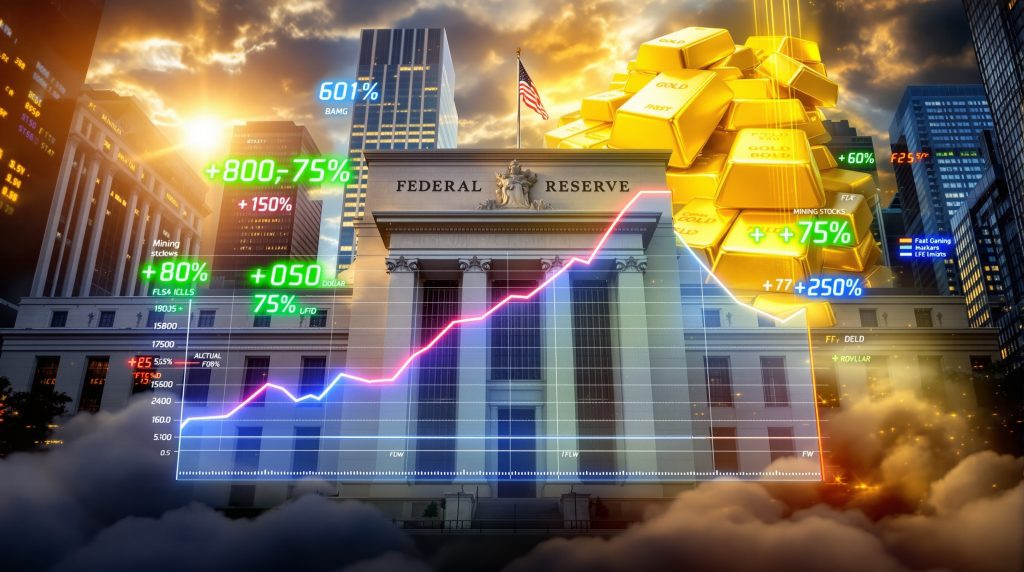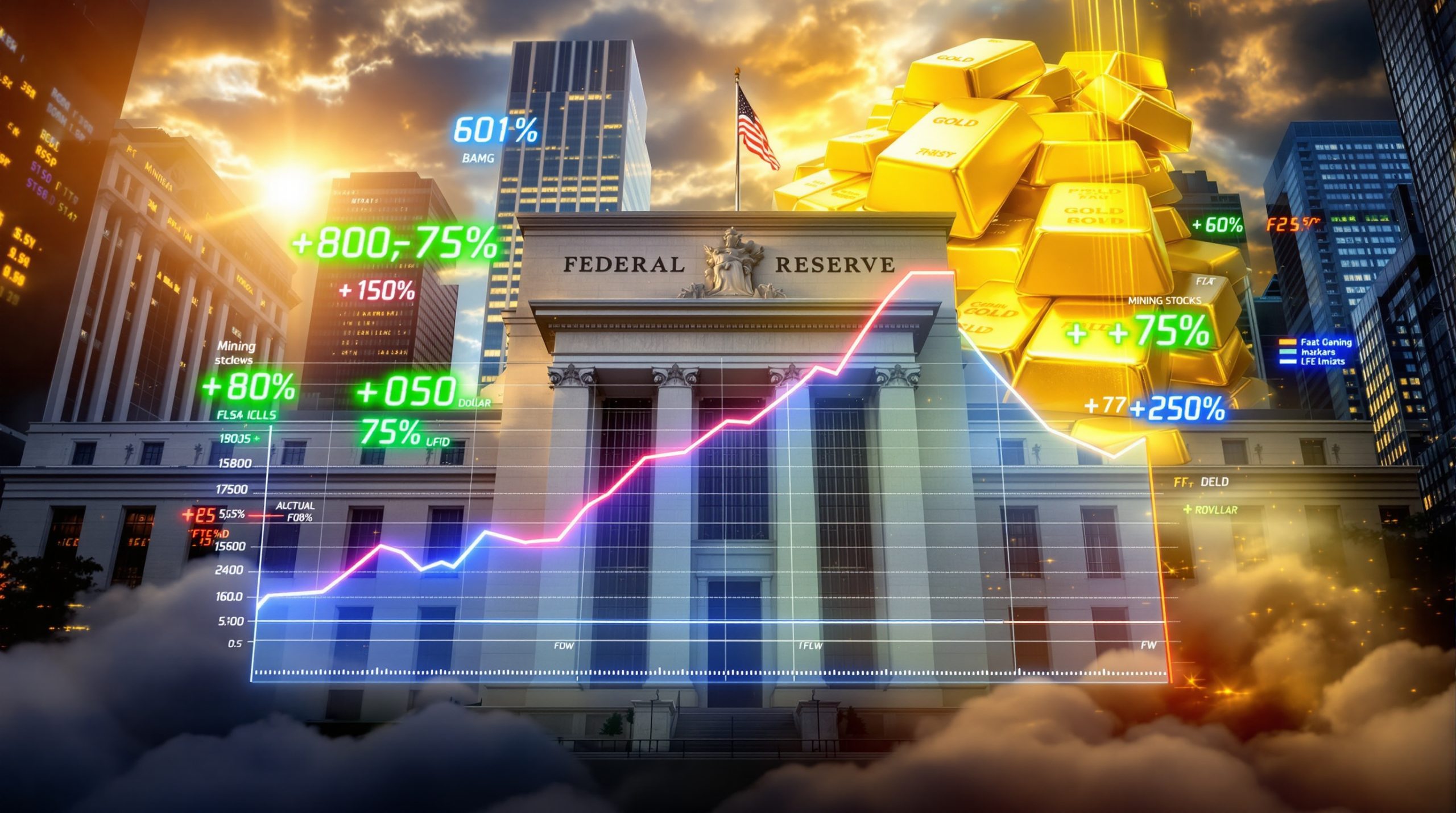How Did Markets React to Fed Rate Cut Expectations in September 2023?
The financial markets experienced significant volatility in September 2023 as investors positioned themselves ahead of a highly anticipated Federal Reserve meeting. Market participants were divided on whether the central bank would maintain its restrictive monetary policy stance or begin a new easing cycle. This uncertainty created notable movements across multiple asset classes, with precious metals showing particular sensitivity to shifting rate expectations.
During this period, gold demonstrated remarkable resilience, hovering around $1,950 per ounce as traders assessed economic indicators and Federal Reserve communications. Mining stocks showed stronger relative performance than the physical metal itself, reflecting the leverage effect that typically occurs in bull markets for precious metals.
Market Sentiment Leading into September 2023
According to CME FedWatch Tool data from that period, approximately 65% of market participants expected the Federal Reserve to maintain rates at the September meeting, while around 35% anticipated some form of rate reduction. This divided sentiment emerged after several Federal Reserve officials, including Governor Christopher Waller, made public statements suggesting openness to policy adjustments if economic data warranted such changes.
Several key factors influenced these expectations:
- A string of public statements from Fed officials that emphasized "data dependency"
- Growing concerns about potential labor market softening despite otherwise resilient economic indicators
- Geopolitical uncertainties adding risk premiums to various asset classes
- Questions about whether the restrictive monetary policy had reached its effective endpoint
The market's reaction was notably measured, as traders had learned to be cautious about interpreting Federal Reserve communications too literally. This cautious approach proved prudent given the outcome of the September meeting.
What Economic Data Influenced Fed Rate Cut Expectations?
Surprisingly Strong GDP Performance
The U.S. economy demonstrated remarkable resilience in 2023, with third-quarter GDP growth reaching 4.9% annualized, according to Bureau of Economic Analysis data. This represented one of the strongest quarters of growth in recent years and significantly outperformed many analysts' expectations.
This robust growth contradicted earlier recession fears and raised legitimate questions about whether rate cuts were necessary at all. The GDP figures were supported by several key components:
- Strong consumer spending, particularly in services sectors
- Business investment in equipment and intellectual property
- Resilient housing market activity despite higher mortgage rates
- Positive contributions from government spending
When comparing U.S. economic performance to other major economies during this period, the contrast was striking. While the U.S. demonstrated robust growth, many other advanced economies struggled with stagnation or minimal expansion.
Employment Concerns vs. Economic Strength
Despite the strong GDP figures, labor market indicators presented a more nuanced picture that influenced Federal Reserve deliberations. While unemployment remained historically low at 3.8% in August 2023, other metrics suggested potential softening:
- Job openings had declined from previous peaks
- The pace of monthly job creation had moderated
- Wage growth had begun to normalize
- Labor force participation remained below pre-pandemic levels
Federal Reserve officials specifically cited these employment metrics as factors they were closely monitoring. In particular, Fed Chair Jerome Powell emphasized the desire to achieve a "soft landing" where inflation could be controlled without triggering significant job losses.
The upcoming September non-farm payrolls report was positioned as a critical data point that would influence the Federal Reserve's decision-making process, with officials specifically mentioning this release in their public communications.
Why Did Gold Prices Show Resilience Despite Rate Uncertainty?
Gold's Response to Monetary Policy Signals
Gold prices demonstrated remarkable stability in the lead-up to September 2023, with the precious metal trading within a relatively narrow range despite significant economic uncertainty:
- Prices maintained support above $1,900 per ounce
- Gold demonstrated strong technical consolidation after earlier gains
- Trading volumes increased ahead of the Federal Reserve decision
- Investment demand remained robust in both Western and Eastern markets
This performance reflected gold's traditional role as a hedge against monetary policy uncertainty and potential currency devaluation. Investors viewed the Federal Reserve's decision point as pivotal, with potential rate cuts likely to reduce the opportunity cost of holding non-yielding assets like gold. Recent gold price highs analysis suggests this resilience was part of a longer-term trend in precious metals markets.
Mining Stock Outperformance
Gold mining stocks significantly outpaced the physical metal's performance, demonstrating the leverage effect mining equities typically provide during periods of gold price stability or growth:
- GDX (VanEck Gold Miners ETF): +46% year-to-date through September 2023
- GDXJ (VanEck Junior Gold Miners ETF): +38% year-to-date through September 2023
- Physical gold: +15% year-to-date through September 2023
This outperformance aligned with historical patterns where mining stocks typically amplify gold price movements due to operational leverage. The sector also saw increased financing activity, with equity raises reaching significant levels by mid-2023, suggesting growing investor confidence in the mining sector's prospects.
Financial analysts noted that mining companies had spent the preceding years strengthening balance sheets and focusing on operational efficiency, positioning them to benefit substantially from stable or rising gold prices. Many experts have identified numerous undervalued mining stocks that continue to show potential despite market volatility.
What Were the Arguments Against a September 2023 Rate Cut?
Economic Strength Contradicting Easing Needs
Several compelling factors challenged the case for monetary easing in September 2023:
-
Exceptional GDP growth: At 4.9% for Q3, the U.S. economy was expanding at a pace that typically wouldn't warrant stimulus.
-
Inflation concerns: While moderating, inflation remained above the Fed's 2% target (3.7% year-over-year in August 2023), raising questions about whether rate cuts might reignite price pressures.
-
Financial stability considerations: Markets were functioning smoothly without obvious signs of stress requiring immediate intervention.
-
Risk of premature signaling: Cutting rates too soon could send unintended messages about economic weakness that didn't align with actual conditions.
Many economists argued that the Federal Reserve's dual mandate of price stability and maximum employment was better served by maintaining rates until inflation had conclusively returned to target levels.
The Dollar's Resilience
The U.S. Dollar Index (DXY) showed remarkable stability despite rate cut speculation, suggesting currency markets weren't fully convinced that significant monetary easing was imminent. This dollar strength contradicted the typical pattern where rate cut expectations often lead to currency weakness.
Several factors contributed to the dollar's resilience:
- Relative economic outperformance compared to other major economies
- Higher yields compared to other developed market currencies
- Safe-haven flows due to geopolitical uncertainties
- Technical support levels maintaining the dollar's trading range
This currency stability provided the Federal Reserve with greater flexibility in its decision-making process, as policymakers didn't need to worry about disruptive dollar movements regardless of their policy choice.
How Did Industrial Metals Respond to Rate Cut Speculation?
Copper's Recovery Signal
Copper prices showed signs of recovery after earlier weakness, with the industrial metal gradually climbing from recent lows. This price action suggested:
- Diminishing recession fears in major economies
- Renewed industrial demand expectations, particularly from Asia
- Easing concerns about potential trade restrictions affecting metal flows
- Growing confidence in continued economic activity
As a key industrial metal often referred to as "Dr. Copper" for its economic diagnostic properties, this recovery provided another data point suggesting economic resilience rather than weakness requiring immediate monetary stimulus. Experts following copper price insights note that industrial metals often provide valuable economic signals beyond what traditional indicators might show.
Industry analysts noted that copper inventories at major exchanges had fallen to multi-year lows, indicating strong physical demand despite macroeconomic uncertainties. This tight physical market created a floor for copper prices even as financial markets debated Federal Reserve policy.
What Political Factors Influenced Fed Policy Expectations?
Federal Reserve Independence Considerations
Political developments created additional uncertainty around Fed policy during this period:
- Public debate about the appropriate role of monetary policy
- Questions about potential changes to the Federal Reserve's mandate
- Broader political considerations affecting monetary policy independence
- Upcoming election cycle increasing scrutiny of economic policy decisions
These factors added complexity to market interpretations of Fed signals and increased the range of potential policy outcomes investors needed to consider. The Federal Reserve, for its part, consistently emphasized its political independence and data-dependent approach throughout this period.
Market participants increasingly recognized that the Federal Reserve's decision-making process was becoming more complex in an environment of competing priorities and heightened political scrutiny.
What Was the Reality of the Fed's September 2023 Decision?
The Actual Policy Outcome
Despite mixed market expectations, the Federal Reserve ultimately maintained interest rates unchanged at its September 2023 meeting. The Federal Open Market Committee (FOMC) voted unanimously to keep the target federal funds rate range at 5.25% to 5.5%, aligning with the majority market expectation but disappointing those who had positioned for an immediate cut.
The Fed's decision reflected:
- Confidence in continued economic expansion despite some labor market concerns
- Caution about still-elevated inflation readings
- A desire to see more evidence of sustainable progress toward policy goals
- Reluctance to reverse course too quickly after an extended tightening cycle
The decision reinforced the Federal Reserve's data-dependent approach and willingness to maintain restrictive policy until inflation conclusively returned to target levels.
Forward Guidance Evolution
Rather than cutting rates, the Fed adjusted its forward guidance to indicate that while the tightening cycle might be complete, the committee remained prepared to adjust policy if risks emerged to either its employment or inflation objectives. This nuanced position aimed to maintain flexibility while acknowledging the balanced risks to the economic outlook.
The FOMC statement and subsequent press conference emphasized:
- The committee's commitment to its 2% inflation target
- Ongoing assessment of incoming economic data
- Readiness to adjust policy if needed
- Recognition of both upside and downside risks to the outlook
This carefully balanced communication allowed the Federal Reserve to maintain policy stability while signaling openness to future adjustments as warranted by economic conditions. Many investors have since turned to gold investment amid inflation concerns as a hedge against potential policy missteps.
What Lessons Can Investors Learn from the September 2023 Fed Decision?
Market Expectations vs. Central Bank Reality
The September 2023 episode highlights several important lessons for investors:
-
Markets can misinterpret signals: Despite some indications from Fed officials suggesting openness to policy adjustments, the committee as a whole maintained a more cautious stance.
-
Economic data trumps rhetoric: The Fed ultimately based its decision on the totality of economic evidence rather than isolated comments from individual officials.
-
Forward guidance complexity: Central bank communication involves nuance that markets sometimes oversimplify into binary "cut or no cut" expectations.
-
Asset price disconnects: Gold's resilience despite no actual rate cut demonstrated that multiple factors beyond monetary policy affect precious metals prices.
Financial analysts noted that this episode reinforced the importance of focusing on fundamental economic data rather than attempting to predict specific policy moves based on isolated statements or market positioning.
Positioning for Future Policy Shifts
The September 2023 experience suggests investors should:
- Focus on comprehensive economic data rather than isolated statements
- Maintain balanced portfolios that can withstand policy surprises
- Recognize that market consensus can be wrong about policy directions
- Consider how geopolitical and structural factors might influence central bank decisions beyond traditional economic indicators
This balanced approach enables investors to navigate policy uncertainty while maintaining exposure to assets that can perform well across multiple economic scenarios.
What Happened to Rate Cut Expectations After September 2023?
Policy Path Recalibration
Following the September 2023 decision to hold rates steady, markets adjusted their expectations for the timing of eventual rate cuts. The Federal Reserve continued to emphasize data dependence while acknowledging that:
- The peak of the tightening cycle had likely been reached
- Future decisions would balance inflation concerns against growth risks
- Labor market developments would remain central to policy considerations
- International developments could influence domestic policy choices
This recalibration process highlighted the dynamic nature of monetary policy expectations and the importance of remaining flexible in investment positioning.
Market participants increasingly focused on the December 2023 meeting as a potential inflection point, with economic data releases between September and December taking on heightened importance for policy expectations. This TikTok video captured the market's anticipation of Jerome Powell's eventual announcement of the first rate cut.
How Did Mining Investments Perform Despite No Rate Cut?
Gold Mining Sector Resilience
Despite the absence of an actual rate cut in September 2023, gold mining investments demonstrated remarkable resilience:
- Major producers maintained strong operational performance
- Development-stage companies secured necessary financing
- Exploration activity increased in key jurisdictions
- Merger and acquisition interest expanded
This performance reflected broader confidence in the gold sector beyond short-term monetary policy considerations, including:
- Long-term inflation concerns
- Geopolitical risk hedging
- Supply constraints in gold production
- Growing institutional interest in the sector
Industry analysts noted that mining companies had spent years improving operational efficiency and strengthening balance sheets, positioning them to perform well even without immediate monetary policy support.
What Were the Implications for International Mining Jurisdictions?
Jurisdictional Risk Considerations
The period surrounding September 2023 also highlighted important jurisdictional risk factors for mining investors:
- Several African mining jurisdictions experienced regulatory changes affecting ownership structures
- Western mining companies faced increasing pressure to address environmental and social governance concerns
- Resource nationalism trends continued to influence mining investment decisions
- Permitting timelines extended in many jurisdictions despite strong metal prices
These developments underscored the importance of jurisdictional diversification in mining portfolios beyond simple exposure to metal price movements.
A notable example occurred in Burkina Faso, where the government requested to acquire an additional 35% stake in certain mining operations, creating significant uncertainty for international mining companies operating in the country. This type of jurisdictional risk remains a critical consideration for mining investors beyond monetary policy factors.
Beyond Rate Cut Speculation: Fundamental Mining Sector Drivers
Operational Excellence Driving Valuations
While monetary policy expectations influenced mining stock performance, fundamental operational factors played an equally important role:
- Cost control initiatives delivering margin improvements
- Technology adoption enhancing productivity
- ESG performance becoming a valuation differentiator
- Reserve replacement strategies determining long-term growth potential
Mining analysts increasingly emphasized that company-specific factors were driving performance differentiation within the sector, with the best-managed companies outperforming regardless of short-term macroeconomic uncertainty.
This focus on operational excellence reflected the mining industry's maturation and the increasing sophistication of investors in the sector who recognized value beyond simple leverage to commodity prices. The sector continues to evolve with new mining evolution trends reshaping how companies operate and create value.
Supply Constraints Supporting Metals Prices
Beyond monetary policy, structural supply constraints supported metals prices during this period:
- Limited new mine development during the preceding bear market
- Declining ore grades at major producing assets
- Lengthening permitting timelines for new projects
- Rising costs for mine development
These supply-side challenges created support for metals prices even as demand uncertainty persisted, providing a favorable backdrop for well-positioned mining companies regardless of the interest rate environment.
Industry experts noted that years of underinvestment in exploration and development had created a situation where even modest demand growth could lead to significant supply deficits in various metals, supporting prices independent of monetary policy developments. Financial influencers on platforms like TikTok have increasingly highlighted these structural factors to their audiences.
Conclusion: Investment Implications of the September 2023 Fed Decision
The September 2023 Federal Reserve meeting and surrounding market dynamics highlight the complex interplay between monetary policy expectations and asset prices. While markets positioned for potential rate cuts that ultimately didn't materialize in that month, the episode provided valuable insights into economic resilience, central bank communication challenges, and the multiple factors driving precious metals performance.
For investors, the experience reinforced the importance of comprehensive analysis beyond headline expectations, particularly in sectors like mining where multiple technical, operational, and jurisdictional factors influence outcomes alongside monetary policy considerations.
The Federal Reserve would eventually begin cutting rates in 2024, but the September 2023 episode serves as a reminder that market timing based on policy expectations alone remains challenging, and diversified approaches considering multiple scenarios typically prove more robust over time.
The mining sector's strong performance despite the absence of immediate rate cuts demonstrated the importance of fundamental analysis and the sector's growing maturity as investors increasingly recognized value beyond simple commodity price leverage.
Want to Profit from the Next Major Mining Discovery?
Discover why significant mineral discoveries can lead to exceptional returns by exploring Discovery Alert's dedicated discoveries page, where their proprietary Discovery IQ model transforms complex mineral data into actionable investment insights. Begin your 30-day free trial today to receive instant notifications on major ASX mineral discoveries before the broader market reacts.




